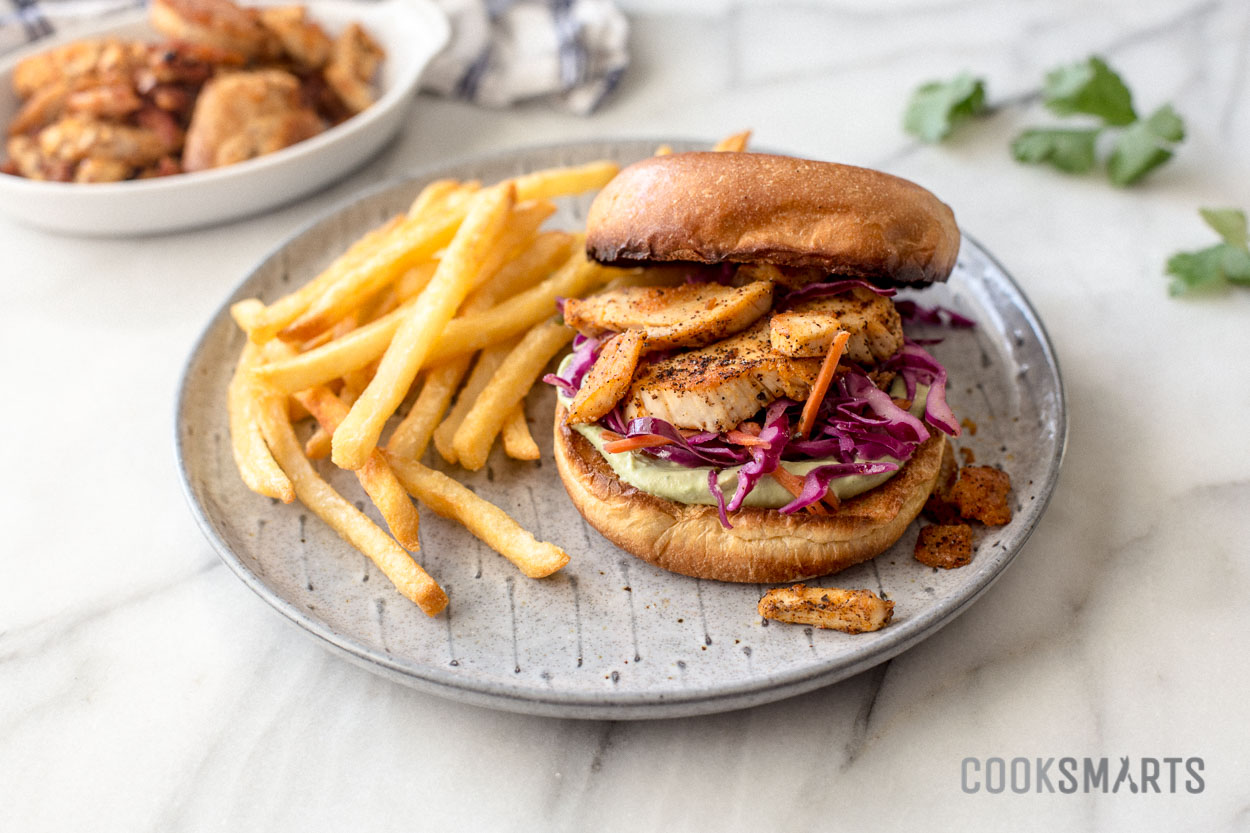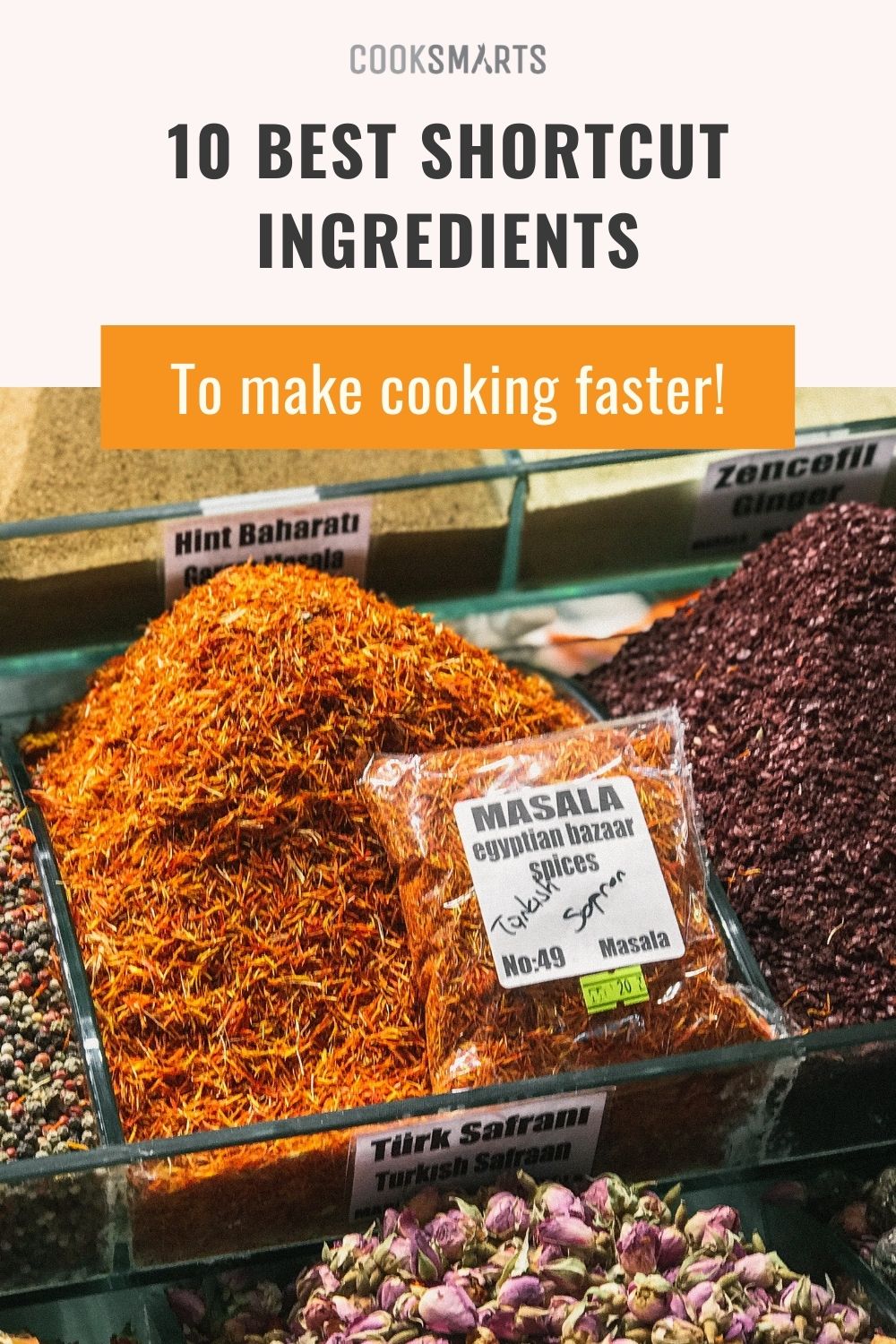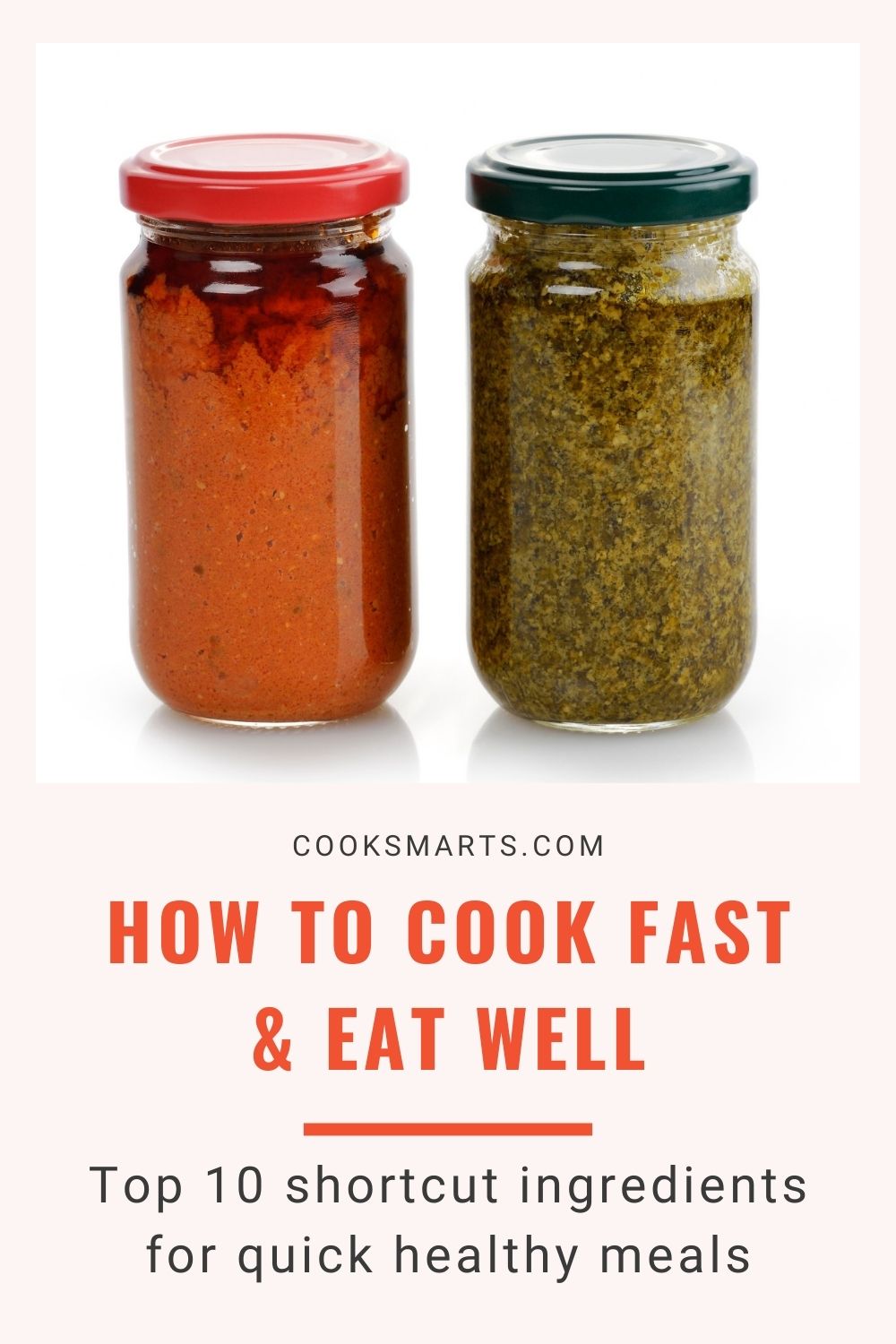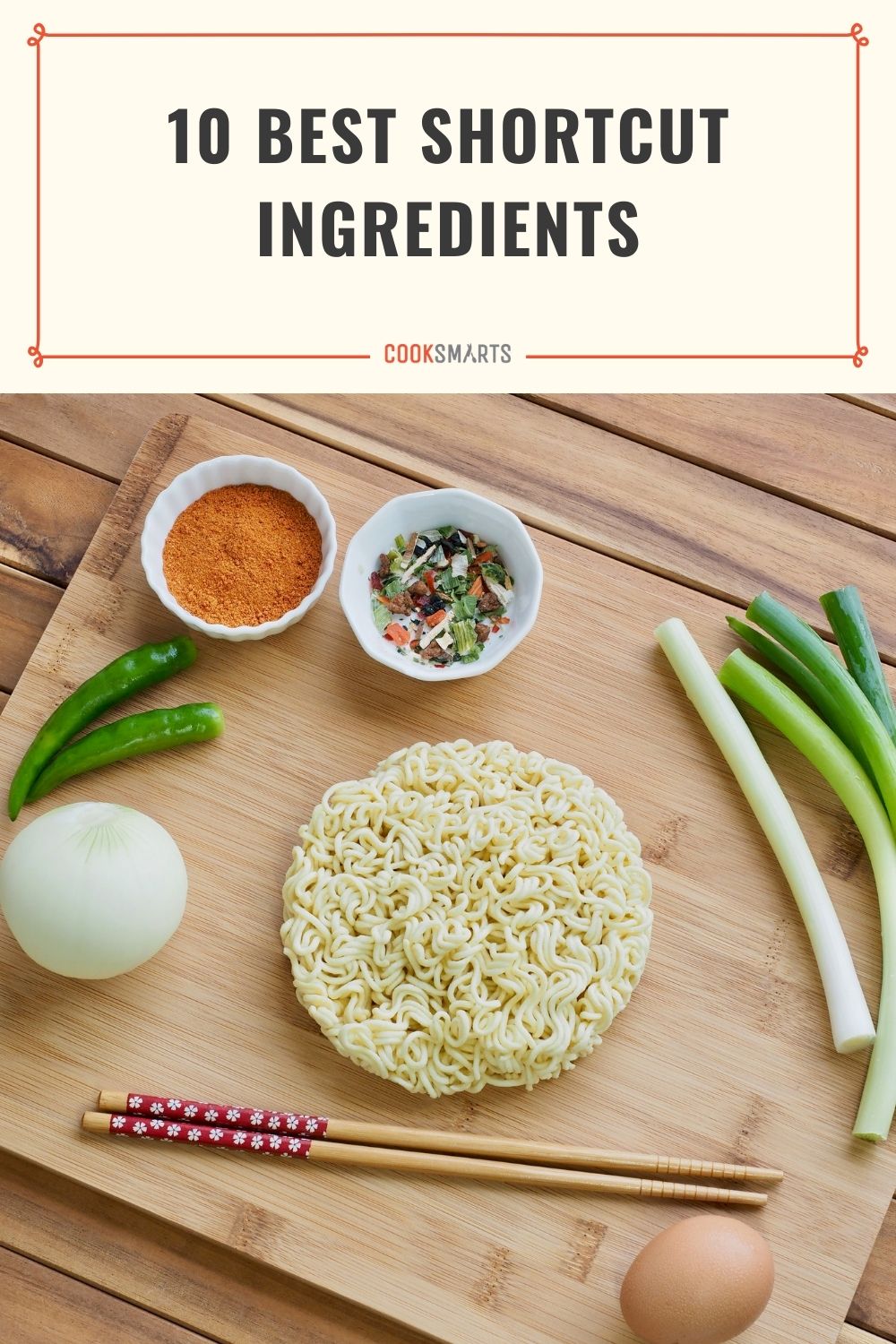10 Best Shortcut Ingredients to Make Cooking Faster
Make home-cooked meals easy with shortcut cooking. (Almost) any meal can be an easy weeknight meal if you know what shortcuts to use and how to sub them into your recipe.
Nothing beats a home-cooked meal. But we all have days — or, let’s be honest, sometimes weeks or months — where cooking every part of our meal from scratch is just a little too taxing.
On those days, it’s tempting to give up and grab some takeout for dinner.
But often, there are compromises we can find between making everything and making nothing in our dinner. Using shortcut ingredients means we can get dinner on the table in less time, with less hassle, and without resorting to Plan B . . . whether that’s takeout, drive-through, frozen meals, or eating handfuls of microwave popcorn and calling it dinner.
Sounds like a win, right? Read on for our 10 favorite shortcut ingredients, as well as some tips for how to sub these ingredients into your existing recipes.

1. Rotisserie Chicken
Between cleaning, marinating, tenderizing, cooking, and resting chicken, a simple chicken meal can turn into a much longer process than we’re up for on some weeknights. That’s why we love getting rotisserie chicken and skipping right to the “slice and serve” step. Pair with a vegetable and a grain, and you have a ready-to-go, semi-home-cooked meal. Rotisserie chicken can also be sautéed with spices or mixed with a creamy sauce for use on tacos or sandwiches, such as in our Latin-Spiced Chicken Sandwich, or is an easy shortcut for chicken pot pie or chicken pasta.
How to sub it into recipes:
Simply skip all the steps in your recipe that involve cooking chicken, and use rotisserie chicken with similar spices once you reach the step where it all comes together. Use about 3 cups of chopped rotisserie chicken per pound of raw chicken in your recipe. The rotisserie chicken can be reheated in the microwave or pan if desired.
2. Pesto
We love a good pesto dish in the height of summer, but making pesto from scratch is a labor-intensive activity. Sub in store-bought pesto instead of making your own, and most people will never know the difference. Pesto is great on pasta, mixed into hummus or other dips, spread on sandwiches, or used to top roasted veggies. (For more ideas, check out our article on 10 Creative Ways to Use Pesto.)
1 Great Pesto Recipe and 10 Delicious Ways to Use It
Our favorite easy summer dinners involve creative ways to use pesto. We’ll share our best pesto recipe, as well as… Read more.
How to sub it into recipes:
1 cup of fresh basil, or approximately ¾ of an ounce, makes about ½ a cup of pesto, depending on your recipe, so use that as a guide when subbing store-bought pesto. But recipes that call for pesto typically don’t require exact amounts; it’s more about how much basil flavor you like. Taste and adjust to your heart’s content!
3. Sauces
Sauces are often one of the more time-intensive parts of a recipe, so if you need a quick and easy meal, they’re a great place to shortcut! Whether you’re making pizza, pasta, enchiladas, or a stir-fry, you’re guaranteed to find a pre-made sauce that’s similar enough to your recipe that you can take the shortcut. Here at Cook Smarts, some of our favorite sauce shortcuts that we use in our meal plans include jarred marinara, ready-to-go enchilada sauce, and barbecue sauce. For example, using a premade barbecue sauce means this Sheet Pan BBQ Sausage meal requires only 30 minutes of hands-on work.
How to sub them in recipes:
Don’t worry too much about the specific ingredients in your recipe — as long as it’s the same type of cuisine (a Thai stir-fry sauce in a Thai recipe, a Mexican-spiced sauce in a Mexican recipe), you can usually sub in a pre-made sauce with no problems. Simply add up the approximate number of tablespoons (or cups) the sauce ingredients in a recipe would make, and use the same amount of your store-bought sauce.
4. Frozen Vegetables
Between washing, peeling, and chopping, prepping vegetables for cooking is a surprisingly time-consuming activity. If you’re not feeling up to the task, you can often sub in frozen vegetables with no problems. Frozen vegetables are ready to use, often available in small diced pieces or larger chops, and you can usually find a mix that works for whatever type of meal you’re making. Our favorites to always have on hand include frozen peas, cauliflower, and mixed veggies, the latter of which we use in our Chicken Pot Pie Soup.
How to sub them in recipes:
Use approximately the same amount of frozen vegetables as your recipe calls for fresh. You don’t have to use the exact same vegetables as your recipe recommends, but stick to the same type and size. For example, any small diced frozen veggie mix can be used in a stir-fry or pot pie; any Normandy blend can be used in recipes that call for broccoli, carrot, and/or cauliflower. Add frozen vegetables in the last few minutes of cooking; see our article How to Use Frozen Vegetables for more info and tips:
How to Use Frozen Vegetables
Cooking frozen vegetables is simple. Here we’ll share the veggies that freeze best and offer a few uses for frozen… Read more.
5. Coleslaw Mix
Coleslaw mix is a surprisingly versatile shortcut! It can be subbed for cabbage in recipes or used as a salad base, and often gives you the nutritional bonus of including multiple types of cabbage plus shredded carrot. Coleslaw mix can be used to add crunch to a salad, helps bulk up a soup, adds extra veggies to a stir-fry, or completes a grain bowl. We even like using coleslaw mix in our Shrimp Fettuccine Alfredo; if you start with a light, finely chopped slaw mix, the cabbage practically melts into the cream sauce.
How to sub them in recipes:
Cabbage can range hugely in size, so most recipes that call for cabbage include measurements by weight. This means that subbing coleslaw mix for cabbage is a simple swap ounce for ounce! If your mix includes carrots or any other type of shredded vegetables, don’t worry about trying to figure out what percentage of the bag is cabbage; just swap it by weight and you’ll be fine.
6. Seasoning Blends
If you hate measuring out spices for a recipe, it’s easy enough to sub in premade spice blends — such as poultry seasoning, ranch seasoning, taco seasoning, and steak seasoning. While you might not create exactly the same flavors by using poultry seasoning instead of the specific mix of spices your roast chicken recipe recommends, you’ll get close enough that it really won’t matter. A variety of seasoning blends can be found at the store, but if you do have time to make your own, consult our Seasoning Blends Chart:
12 Seasoning Blend Recipes
Keep your favorite seasoning blends on hand, so you can make cooking extra flavorful and easy.
Make Meals Flavorful and Easy
Keep these homemade seasoning blends on hand to make cooking a whole lot easier!
I acknowledge by requesting this info, I'll be added to Cook Smarts' newsletter list. I can unsubscribe at any time.
How to sub them in recipes:
This one is easy. Simply approximate the total amount of herbs or spices your recipe calls for, and use the same amount of your seasoning blend. Don’t worry too much about the exact ingredients or proportions in your blend; as long as it’s intended to be used in a similar meal to what you’re making, it’ll work out great. For example, in our Chicken Fajita Salad, you could toss your chicken with a tablespoon of taco seasoning or fajita seasoning (for 4 portions) instead of measuring out coriander, paprika, cumin, chili powder, salt, and pepper. (Do make sure your seasoning mix includes salt and pepper before omitting those, though!)
7. Precooked Grains or Riced Cauliflower
Most grains can be subbed for one another easily, so keeping some precooked grains or riced cauliflower on hand is a simple way to get a meal on the table fast. Precooked grains can be found in shelf-stable packets, frozen, or in a grocery store’s house-prepared foods section; cauliflower rice is typically sold frozen or in the refrigerated part of the produce section. Though the step that’s cut out differs (cooking the grain versus grating or food processing the cauliflower), the result is the same: a side that requires heating for just a few minutes before serving.
How to use them in recipes:
Most grains can be subbed for one another easily, so don’t worry too much about the type or types of grains a recipe calls for. Leave out any cooking liquid when using pre-cooked grains, of course, but you can stir herbs or spices from the recipe into pre-cooked grains. For cauliflower rice, 1 pound of cauliflower is equivalent to about 4 cups of riced cauliflower.
8. Minced Garlic
If chopping garlic tends to slow you down in your meal prep, it can be a game-changer to switch to jarred minced garlic (go ahead, call it “jarlic” — we know you want to!). Garlic adds such great, rich flavor to meals that we never want to leave it out, but it can be finicky to chop. Plus, leave the pieces too big and you’ll get bursts of overly strong garlic flavor that can ruin a bite. Minced garlic is a great time-saver that lasts for months in the fridge.
How to use it in recipes:
Sub ½ teaspoon of minced garlic per clove of garlic the recipe calls for. We prefer to use freshly chopped garlic in raw uses such as vinaigrettes and other uses where garlic is front and center (think garlic bread), but jarred garlic is just as good for most other purposes.
9. Ramen Packets
Fresh ramen makes for a delicious meal, but it’s not exactly healthy or satisfying to slurp noodles in salty broth alone. That’s why we like to use ramen packets as a building block to a meal. You can either use the soup mix and noodles from a packet of ramen and add your own vegetables and proteins to create a meal, or you can ditch everything but the noodles and make your own broth in addition to the other toppings. You can even use uncooked instant ramen noodles to add crunch to a salad, as we do in our Asian Chicken Salad with Crunchy Ramen.
How to sub it in recipes:
If you’re using the soup packet as your ramen broth, skip any steps in your recipe that call for making and/or flavoring broth — or add additional flavors as you desire. If you’re subbing dried ramen noodles where the recipe calls for fresh, use half the amount to account for the water weight included in fresh noodles. Check out our ramen cooking formula for making a meal from ramen packets without a specific recipe:
Cooking Formula: Ramen
Knowing how to make ramen broth will benefit you, whether you prefer homemade spicy ramen or homemade udon noodle soup. Read more.
10. Leftovers
Our favorite shortcut of all? Using something you’ve already cooked, mixed, or chopped from an earlier meal. We love doubling our salad dressings, roasting extra veggies, and making extra proteins for lunches or easy dinners later in the week. (Sometimes we even incorporate this sort of shortcut into our meal plan menus, such as using leftover Slow Cooker Pot Roast to make French Dip Sandwiches.)
How to sub them in recipes:
Get creative! Add leftover roast veggies to dinner salads, tacos, or rice pilaf. Use leftover chicken on sandwiches, chopped in soup, or on a salad. Use leftover vinaigrette on salads, as a marinade, or toss with root veggies before roasting. Whether you sub leftovers for other ingredients in a recipe or just add them in addition, using ingredients you’ve already cooked will save you time, reduce food waste, and just might give you your new favorite flavor combination! Get more detailed ideas with our infographic Guide to Repurposing Leftovers & Leftover Ingredients:
How to Repurpose Leftovers & Leftover Ingredients to Save Money
Instead of wondering, “how long do leftovers stay good?”, we have an infographic that will help you use leftover ingredients… Read more.
We’re here to help you live your best life in the kitchen and provide delicious memories for you and your family. Join our cooking community by signing up for our newsletter below, and we’ll send you great cooking tips and resources that will help you raise your kitchen IQ and cook with confidence.



